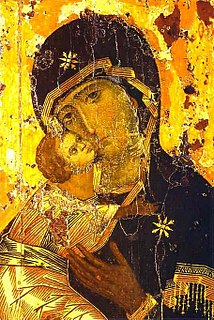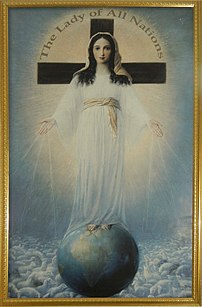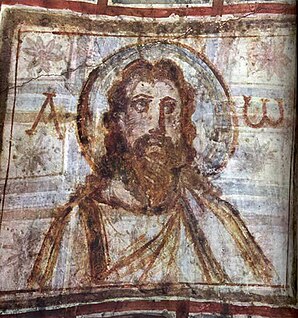This article has multiple issues. Please help improve it or discuss these issues on the talk page . (Learn how and when to remove these template messages) (Learn how and when to remove this template message)
|
Nova Eva is a devotional name for the Virgin Mary, mother of Jesus Christ, and is possibly the most ancient doctrinal title of Our Lady in the Early Church. Eastern and Western Fathers of the Church alike express the doctrinal message that goes back to Apostolic times and which constituted the universal teaching of the Early Church: the doctrine of Mary’s necessary participation in the redemption of humanity as the New Eve. (Miravalle, Mary: Coredemptrix, Mediatrix, Advocate) Mary as Nova Eva represents the first theological reflection of the Mother of God, the title’s remote origins tracing back to Papias, Bishop of Hierapolis in Asia Minor at the turn of the first century. The title’s development can be broken into three stages: its remote origins before Nicaea, the enthusiasm and contributions by Church Father Ephraem, and the full flowering of the patristic vision in the homiletic literature of the fifth century.(Gambero, Mary and the Fathers of the Church)
Redemption is an essential concept in many religions, including Judaism and Christianity. The English word "redemption" means 'repurchase' or 'buy back.
Papias was a Greek Apostolic Father, Bishop of Hierapolis, and author who lived c. 60–163 AD. It was Papias who wrote the Exposition of the Sayings of the Lord in five books.

Ephrem the Syrian was a Syriac-Aramean Christian deacon and a prolific Syriac-language hymnographer and theologian of the fourth century.
Our Lady as the Nova Eva finds its origin in the Bible, stemming first from the Pauline doctrine of the second Adam: “since by man came death…in Christ shall all be made alive.” (1 Corinthians 15: 21-22) Dogma of the Church recognizes Christ as the New Adam, as the One who redeemed mankind from the original sin inflicted by Adam and Eve on all.

The Bible is a collection of sacred texts or scriptures. Varying parts of the Bible are considered to be a product of divine inspiration and a record of the relationship between God and humans by Christians, Jews, Samaritans, and Rastafarians.

Original sin, also called ancestral sin, is a Christian belief in the state of sin in which humanity has existed since the fall of man, stemming from Adam and Eve's rebellion in Eden, namely the sin of disobedience in consuming the forbidden fruit from the tree of the knowledge of good and evil. This condition has been characterized in many ways, ranging from something as insignificant as a slight deficiency, or a tendency toward sin yet without collective guilt, referred to as a "sin nature", to something as drastic as total depravity or automatic guilt of all humans through collective guilt.

Adam and Eve, according to the creation myth of the Abrahamic religions, were the first man and woman. They are central to the belief that humanity is in essence a single family, with everyone descended from a single pair of original ancestors. It also provides the basis for the doctrines of the fall of man and original sin that are important beliefs in Christianity, although not held in Judaism or Islam.
“When the woman saw that the tree was good for food, and that it was a delight to the eyes, and that the tree was desirable to make one wise, she took from its fruit and ate; and she gave also to her husband with her, and he ate.”
The Eve of the Old Testament is tempted by the serpent and disobeys God. Eve became for mankind a cause of death, and it is through her that death came into the world. The human race, through Eve who is a virgin, is lost: as death had come through Eve, still a virgin, it was proper that life should come again through a Virgin, or rather of a Virgin; and because the serpent had deceived that one, it was but right that Gabriel should bear the good tidings to the other. It is Mary’s obedience to the God that makes up for the disobedience of Eve. In the mystery of the Annunciation the Virgin Mary takes the role of the New Eve:

The Old Testament is the first part of Christian Bibles, based primarily upon the Hebrew Bible, a collection of ancient religious writings by the Israelites believed by most Christians and religious Jews to be the sacred Word of God. The second part of the Christian Bible is the New Testament.

Gabriel, in the Abrahamic religions, is an archangel. He was first described in the Hebrew Bible and was subsequently developed by other traditions.

The Annunciation, also referred to as the Annunciation to the Blessed Virgin Mary, the Annunciation of Our Lady, or the Annunciation of the Lord, is the Catholic and Eastern Orthodox celebration of the announcement by the Archangel Gabriel to the Blessed Virgin Mary that she would conceive and become the mother of Jesus, the Son of God, marking His Incarnation. Gabriel told Mary to name her son Yeshua, meaning "YHWH is salvation".
“And in the sixth month, the angel Gabriel was sent from God into a city of Galilee, called Nazareth, unto a virgin betrothed to a man whose name was Joseph, of the House of David; and the virgin’s name was Mary. And the angel being come in, said unto her: Hail, full of grace, the Lord is with thee: blessed art thou amongst women. Who having heard, was troubled at his saying, and thought with herself what manner of salutation this should be. And the angel said unto her: Fear not, Mary, for thou hast found grace with God. Behold, thou shalt conceive in thy womb, and shall bringeth forth a son; and thou shalt call his name JESUS. He shall be great, and shall be called the Son of the Most High; and the Lord God shall give unto him the throne of David his father; and he shall reign in the house of Jacob forever. And of his kingdom there shall be no end. And Mary said to the angel: How shall this be, seeing I knoweth not a man? And the angel answering, said unto her: The Holy Ghost shall come upon thee, and the power of the Most High shall overshadow thee; And therefore also, the Holy which shall be born of thee, shall be called the Son of God. And, behold, thy cousin Elisabeth, she also hath conceived a son in her old age; and this is the sixth month with her, who was called barren. Because no word shall be impossible with God. And Mary said: Behold the handmaid of the Lord; be it done unto me according to thy word. And the angel departed from her. (Genesis 3)
The Virgin Mary was found obedient, Eve disobedient. While Eve was a virgin, she did not obey, becoming the cause of death to herself and humanity, so Mary, being obedient became for herself and all of humanity the cause of salvation. (St. Irenaeus, Adversus Haereses) Irenaeus of Lyons is one of many Church Fathers to give insight on the Eve-Mary parallel when he states: “Even though Eve had Adam for a husband, she was still a virgin…by disobeying, she became the cause of death for herself and for the whole human race. In the same way, Mary, though she also had a husband, was a still a virgin, and by obeying, she became the cause of salvation for herself and for the whole human race…the knot of Eve’s disobedience was untied by Mary’s obedience. What Eve bound through her unbelief, Mary loosed by her faith.” (Gambero, Mary and the Church Fathers)

The Church Fathers, Early Church Fathers, Christian Fathers, or Fathers of the Church were ancient and influential Christian theologians and writers. There is no definitive list. The era of these scholars who set the theological and scholarly foundations of Christianity largely ended by AD 700.
Consequently, the Eve-Mary parallel is one that contrasts ‘disobedience and obedience, sorrow and joy, woman cursed and woman blessed, a despot devil and a captive devil, darkness and light, sin and salvation, fall and restoration, condemnation and redemption, death and life, paradise lost and paradise regained.’ Church dogma, Sacred Tradition, and the modern life of the Church reflect ongoing belief in, and devotion to Mary as the New Eve. Throughout the history of the Church, people have turned to the Blessed Virgin Mary as a spiritual mother, as the one who is cause of their invitation to life because she ‘gave birth to Him who lives, to Life itself, the Lamb of whose glory, as of fleece, a garment of immortality has been fashioned…’ Justin Martyr, the first author to use the Eve-Mary parallel writes ‘In Holy Scripture, Eve is called mother of the living.’ (Gambero, Mary and the Church Fathers) It is Mary who fulfills this title in her obedience to God in becoming the bearer of the Redeemer.
Dogma is an official system of principles or doctrines of a religion, such as Roman Catholicism, or the positions of a philosopher or of a philosophical school such as Stoicism.

Justin Martyr was an early Christian apologist, and is regarded as the foremost interpreter of the theory of the Logos in the 2nd century. He was martyred, alongside some of his students, and is considered a saint by the Roman Catholic Church, the Anglican Church, the Eastern Orthodox Church, and the Oriental Orthodox Churches.
The Virgin Mary is, in some genuine sense, responsible for the redemptive effects achieved by her Son; she co-operated in the objective Redemption. In the tradition of the patristic East the Second Eve is “cause of salvation,” “gate of salvation,” she paid Eve’s debt to sin, “helped justice enter in.” She is “cause of life”; she “brought immortality to the world.” Through her “Eve has been redeemed”; through her “the world has been set free.” She has deposed the devil from his despotic rule; she trampled Satan underfoot, through her the “demons have been hurled into hell.” (Mariology v. II)
In a religious context, sin is an act of transgression against divine law. In Islamic ethics, Muslims see sin as anything that goes against the commands of Allah (God). Judaism regards the violation of any of the 613 commandments as a sin.

Satan, also known as the Devil, is an entity in the Abrahamic religions that seduces humans into sin or falsehood. In Christianity and Islam, he is usually seen as either a fallen angel or a jinn, who used to possess great piety and beauty, but rebelled against God, who nevertheless allows him temporary power over the fallen world and a host of demons. In Judaism, Satan is typically regarded as a metaphor for the yetzer hara, or "evil inclination", or as an agent subservient to God.
She appears in this way as the Coredemptrix, “with the Redeemer.” Within Church teaching lies the doctrine of Mary as Coredemptrix, as she who was the instrument with which mankind was redeemed. Drawing upon the Old Testament the Church finds Eve to be co-peccatrix, “with the Sinner,” because it was Eve who freely gave the “instrument” of the Fall. It is Eve who gave the “forbidden fruit” to Adam, the Peccator, “the Sinner,” whose sin as father of the human race led to the loss of grace for the human race. This makes Mary Coredemptrix because she freely gave the instrument of the Redemption in her Fiat, in giving her body to bear Jesus Christ, our Redeemer. St. Ephraem called Mary “the price of the redemption of captives,” and it is in this way that the Church looks to her as “Mother of the Living.” Through her obedience and faith, Mary became the New Eve as the Coredemptrix. (St. Thomas Aquinas, Summa Theologica)
Further Quotes and Poetry on the Nova Eva: “A virgin, a bit of wood, and now death symbolize our defeat. See now how these three things have become for us a principle of life. For Eve there is Mary; for the tree of the knowledge of good and evil there is the wood of the Cross; for the death of Adam there is the death of Christ. Do you see the demon prostrated by the very weapons which had rendered him victorious?”
Amphilochius of Iconium, On Christmas …O Mary, O Mary, the Maker of all things was your firstborn Son! O humanity, who became the bodily substance of the Word and for that reason became more honorable than the spiritual virtues of heaven! For Christ did not want to clothe himself in the form of archangels or in the form of the immaterial figures of the principalities, virtues, and powers; rather, through you, he clothed himself in your form, which had fallen and become like that of the brute animals. …but where now is that hostile and bewildered dragon? Where is that cursed and execrable dragon, who had claimed that this throne would be raised to the heights of heaven?
Caelius Sedulius (d. ca. 440-450) Because of one man, all his descendents perished; And all are saved because of one man. Because of one woman, the deadly door opened; And life returned, because of one woman. (Elegia)
We are the blind offspring of the children of pitiful Eve, Bringing with us the shadows born of an age-old error. But when God deigned to assume the mortal form Of a human nature, then came forth from the Virgin A world of salvation…









